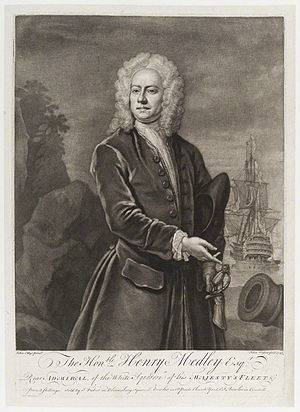Henry Medley
| Henry Medley | |
|---|---|

Henry Medley, 1745 engraving by John Faber the Younger after John Ellys
|
|
| Born | 1687 |
| Died | 5 August 1747 Aboard HMS Russell, at Vado Ligure |
| Allegiance |
|
| Service/branch |
|
| Rank | Vice-Admiral of the Red |
| Commands held |
HMS Poole HMS York HMS Leopard HMS Romney HMS Nassau |
| Battles/wars |
War of the Spanish Succession War of the Quadruple Alliance Anglo-Spanish War War of the Austrian Succession |
Henry Medley (1687 – 5 August 1747) was an officer of the Royal Navy, rising to the rank of vice-admiral.
Medley entered the Royal Navy in 1703, and in 1706 was midshipman of the 80-gun HMS Somerset with Captain Price at the relief of Barcelona. He passed his examination as lieutenant on 8 February 1710, and on 5 September 1710 was promoted by Sir John Norris to be lieutenant of HMS Fame; a few months later he was moved into the 70-gun HMS Stirling Castle. In 1717 he was a lieutenant of the 90-gun HMS Barfleur, flagship of Sir George Byng in the Baltic Sea.
Early in 1720 Medley was promoted to the command of HMS Poole, a fire-ship, and on 17 February 1721 was posted into the 60-gun HMS York. In 1722, while commanding the 50-gun HMS Leopard in the Mediterranean, he seized a ship named the Revolution, lying within the mole of Genoa, on information of her being in the service of the Old Pretender. He later commanded the Leopard on the coast of Portugal and in the English Channel until the end of 1728.
From 1731 to 1735 Medley was employed on the home station. In 1739 and 1740 he was on fishery protection with the Newfoundland fleet, in HMS Romney. At this period he was Governor of Newfoundland.
In 1741 Medley commanded the 70-gun HMS Nassau in the Channel Fleet under Sir John Norris, and in 1742–4 was with Norris as captain of the fleet. On 19 June 1744 he was promoted to be rear-admiral of the white, and in the following winter commanded a squadron cruising in the Channel Soundings for the protection of trade.
...
Wikipedia
